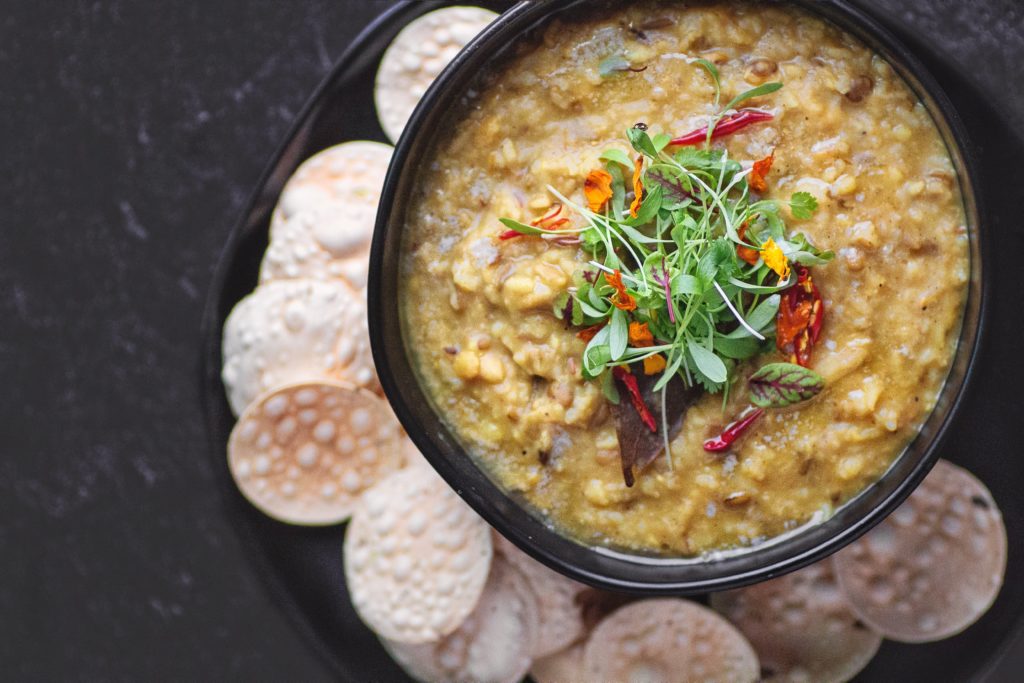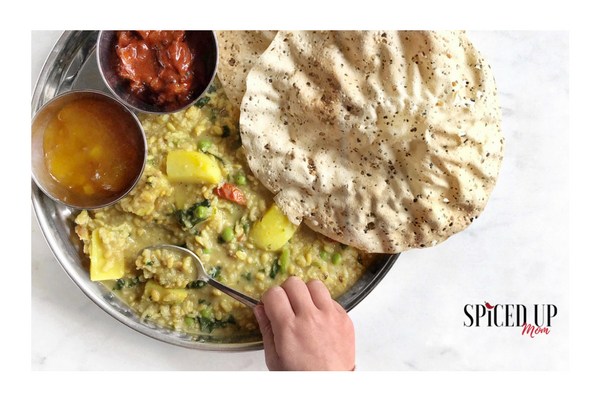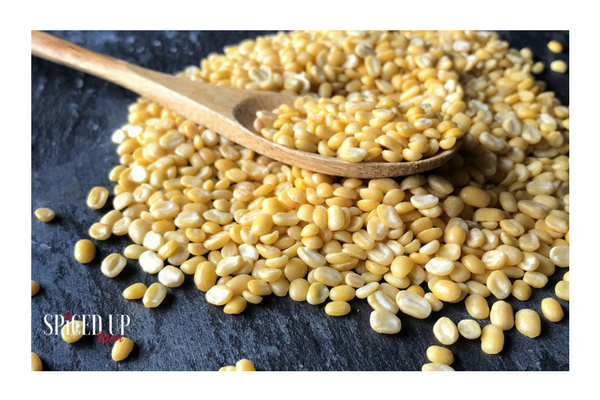Khichdi. Khichurdi. Khichuri.
No matter how you spell it, this dish–made of rice and dal (lentils)–is the epitome of Indian comfort food. It’s one of the first foods Indian children are given and any aunty will tell you that it is the best food to soothe an aching stomach. Simply put, khichdi is Indian “soul food.”
It’s love in a bowl.

My oldest boy, Arjun, absolutely loves khichdi. It’s his favorite food and he requests it nearly once a week. Making khichdi is easy and doesn’t take much time, but with both [extremely busy] boys, time is something I don’t have a lot of.
I decided to adapt my usual recipe for the Instant Pot, this way I wouldn’t have to sit around and wait for my traditional pressure cooker to whistle (release steam).
I swear, my cooker always waits to whistle until the baby is sleeping peacefully and I’m nap-trapped. It’s timing is impeccable.
No Pressure cooker, No problem! You can easily make this recipe on the stovetop using a heavy bottomed pot/dutch oven. Follow the instructions as they’re outlined in the recipe (ignore the pressure-cooker specific parts). The khichdi will take a lot longer to cook. Probably close to an hour or even more. You will need to monitor the pot as it’s cooking and add additional HOT water as necessary.
Khichdi is an extremely simple dish. Usually very minimal spices are used, but there are hundreds of ways to make it. Each region in India has their own style, and honestly, I think each home/cook also has their own special version.

I usually make Bengali bhog style khichdi, but add a few of my own touches. Aside from the classic spices and aromatics, I also tip in a bit of cinnamon, clove, cardamom and mace.
If you don’t have these spices, no problem! You can leave them out and it’ll still taste delicious. I also tend to add whatever veggies I have in the fridge.
Bengali bhog khichdi is typically served at the temples during puja-time (especially Durga Puja, Kali Puja and Saraswathi Puja). It’s offered to the Goddess/God and is made without the use of onion and garlic. In Bengali culture this is considered to be purely vegetarian food and therefore makes the perfect offering.
Bhog khichdi is made using moong dal (sometimes masoor dal is used) and a special type of rice called “Gobindo Bhog” or kala jeera rice. You may also find this rice sold as “baby basmati.” It can be a bit difficult to find but regular basmati rice also works just fine.

This electric pressure cooker (Instant Pot/Ninja Foodi) version is really so easy to make. And although it’s simple food (and by no means the prettiest), it is also quite comforting.
You can serve it by itself, but I usually like to crisp some papads in the microwave (way less greasy than the fried ones! 1 minute in the microwave on High. Then I flip it and do another 10-20 seconds if needed.) and serve some mixed veg. pickle on the side. Pakoras or Bengali beguni (fried eggplant) are also excellent accompaniments!
This khichdi recipe is gluten free and also can be made vegan by simply substituting the ghee with a vegan alternative.
If you’re making this dish vegan, substituting the ghee with a butter alternative will give the best flavor. You can also use oil to cook the dish and finish with a bit of butter substitute.
Add in any vegetables you choose. I like to use peas, spinach and potato (see recipe notes below). I’ve even added some leftover chicken to our finished khichdi–so add whatever you’d like to make it your own (or to clean out your refrigerator 😉).
Watch me make khichdi in the video below!
Pin This For Later
This recipe was updated slightly on 3/24/20 from an earlier version.
Follow along and stay tuned for more recipes (and updates)!
I’m most active on Instagram, Facebook and Twitter. You can also choose to enter your email in my sidebar and have any updates sent straight to your inbox!👍 😀❤
Easy Bengali Style Bhog Khichdi in the Instant Pot

Khichdi (an Indian dish made with rice and lentils) is extremely simple to make. Usually very minimal spices are used, but there are hundreds of ways to prepare it. Each region in India has their own style, and honestly, I think each home/cook also has their own special version.
Use this recipe as a guide and make it yours! If you don't have (or like) a particular spice, it's okay to leave it out.
If you do not have an electric pressure cooker (like an instant pot or Foodi Ninja) you can still make this dish on the stovetop or in a traditional-style pressure cooker (see recipe notes).
- 1 cup split moong dal ((choose the yellowish ones "without skin." Moong dal with the skin on (greenish in color) will also work but your dish may turn out darker in appearance).)
- 1 cup rice, rinsed and soaked approx 20 minutes (ideally, Kala Jeera (gobindo bhog) rice or Basmati rice)
- 3 tbsp ghee (may sub oil if making Vegan, but ghee gives the dish additional flavor. (more to finish the dish))
- 1 tsp whole cumin seeds
- 2-3 dried bay leaves
- 1 dry, red chili (may be omitted–I usually skip it if I'm making this for my younger son)
- 1-3 green chilies, slit (use according to spice preferences)
- 2 tbsp ginger paste (if using fresh ginger: about 1" piece (size of thumb), finely grated)
- 1 tsp coriander powder
- 1 tsp red chili powder ((I use deggi mirchi), adjust or omit according to spice preferences)
- 1/2 tsp. turmeric powder
- 2 tsp garam masala ((possibly a bit more to finish the dish))
- 1/4 tsp cinnamon powder
- 1/4 tsp green cardamom powder
- 1/4 tsp mace powder ( (may sub. nutmeg powder))
- 1/8 tsp clove powder
- 1 tsp sugar
- 5 cups water ((more to thin out the khichuri after cooking))
- salt, as required (I prefer kosher salt)
- Vegetables, as desired. Potatoes, cauliflower, green peas, carrots, spinach are a few of my favorites to add–use what you have! ( optional, (see notes*))
- 1 handful fresh coriander leaves (and stems), chopped finely (optional, for garnish)
-
Before starting to cook your dish, ensure all your ingredients are prepped and ready (mise en place). The actual hands-on cooktime is relatively small for this recipe and spices can quickly burn in the instantpot or other electric pressure cooker.
-
Rinse the rice in cold water. Once rinsed, set the rice in a bowl filled with water and allow the rice to soak while you begin to assemble the dish (15-20 minutes of soak time should be plenty).
-
Heat a pan over medium high heat and once it's hot add the dried moong dal. Dry roast the dal for a few minutes or until you notice they begin to change color (turn a bit brown) and give off a nutty aroma. The time may vary, but watch them closely. You don't want them to burn!Once the dal is roasted, transfer into a strainer. Pour water over the dal to cool it down and stop the cooking. Set the dal aside.
-
Set your Instant Pot to "Saute" mode. Add ghee or oil. I also like to add the ginger at this time–this helps to keep it from splattering everywhere.
-
Once the ghee is warm, tip in the cumin seed. Cook everything until the cumin seeds begin to sizzle and "dance" a bit. Add the bay leaves and dried red chili (if using). Also add in the slit green chilies now. Stir everything together for a minute and then add in the sugar and dry spices: coriander, garam masala, turmeric, red chili, cardamom, clove, cinnamon and mace (or nutmeg). Stir and cook the spices for a minute or so-until they begin to smell fragrant.
-
You may notice the spice mix (masala) beginning to stick to the bottom of the pot. At this point tip in the roasted dal. Stir to mix, scraping up anything that has stuck to the bottom of the pot. Add 1/2 cup of water to this mix. Once the water/dal mix begins to boil, strain the rice. Add the rice into the pot and stir to combine.
-
Add the remaining 4.5 cups of water and 1.5 tsp salt (you'll need more after cooking, depending on your tastes). Turn off the "Saute" mode on your pot. You can add veggies/greens at this point if you desire (see notes below)–I like to add fresh spinach or carrots before pressure cooking. Most veggies I either cook separately or add at the end.
-
Close the lid and turn the vent to the "Sealing" position. Once the pot is sealed, choose the "Pressure Cook" mode (set to high) and set the timer for 20 minutes. While the dal/rice mix is cooking, prep and cook any veggies you'd like to add.
-
Once the Instant Pot beeps, telling you the 20 minutes has passed, you can either let the pressure release naturally (I usually let it naturally release 10-20 minutes before manually releasing the remaining pressure–follow the manufacturer's directions for the model you are using) or you can choose to quick release the pressure right away. In my experience, the pressure release doesn't seem to impact the recipe all that much.
-
When the pressure has released and it is safe to open the lid, do so.
-
Stir everything around–it will look a bit dry and mushy. We like our khichdi a bit on the "wet" side, so I add about 2-3 cups of water and stir everything until it's well mixed. Add more or less water, depending on the consistency you prefer.
-
Taste your food. You may find you need additional salt. Aside from the salt, I usually add a heaping spoon of ghee and 1-2 tsp. additional garam masala (this can give your dish a "kick," so be a bit cautious of that).
-
Garnish your khichdi with chopped coriander leaves (cilantro), if desired. Serve with cooked poppadoms (papad) or fried veggies (such as potatoes or eggplant). A fried egg is also a great accompaniment. I like to top my khichdi with some fresh microgreens and eat it with a side of spicy, Indian pickle.
- No Pressure cooker, No problem! You can easily make this recipe on the stovetop using a heavy bottomed pot/dutch oven. Follow the instructions above. The khichdi will take a lot longer to cook. Probably close to an hour or more. You will need to monitor the pot as it’s cooking and add additional HOT water as necessary.
- If making bhog khichdi (to give as an offering), be sure not to use any onion or garlic as these are not considered pure vegetarian items in Bengali culture. If you’re not making this as an offering and you like the taste, feel free to add in garlic and onions. You can use about 1/2 onion (I like to slice it thinly) and 1/2 tbsp. garlic paste.
- Before adding any green chilies (if using), take the stem off. I then cut two or three small slits in the chili’s skin, being sure not to expose the seeds. Green chilis can vary in their heat levels. I tend to use 2 or 3 for our family. This usually yields a slightly spicy dish, but not overpowering (both my young boys can tolerate).
- If adding vegetables, I usually like to wait until the dish has finished cooking so that they don’t become too mushy. Carrots and fresh spinach are an exception as those can be added prior to pressure cooking. I like to cook potatoes and cauliflower in a bit of turmeric and ghee before tossing in the finished khichdi. I typically add green peas and frozen spinach directly from the freezer once I have released the pressure. The amount of vegetables you add is solely up to you. I usually add about 1 c. of peas, 1-2 medium potatoes, a couple diced carrots, a few handfuls of spinach and 1 cup, or so of cauliflower. You could also add a bit of tomato. Use what you like or what you have on hand.
- This dish can easily be made vegan. Use oil to cook the dish and a Vegan butter substitute to finish/enhance the flavor of the dish.





